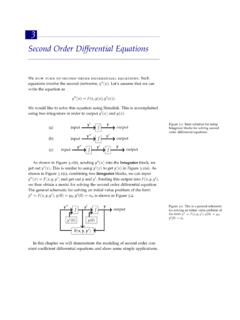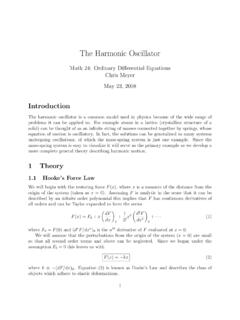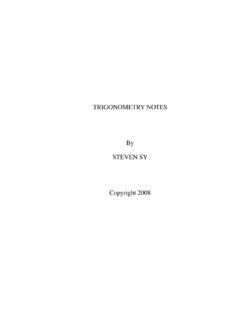Transcription of Forced Oscillation and Resonance - MIT OpenCourseWare
1 Chapter 2 Forced Oscillation and Resonance The Forced Oscillation problem will be crucial to our understanding of wave phenomena. Complex exponentials are even more useful for the discussion of damping and Forced oscil-lations. They will help us to discuss Forced oscillations without getting lost in algebra. Preview In this chapter, we apply the tools of complex exponentials and time translation invariance to deal with damped Oscillation and the important physical phenomenon of Resonance in single oscillators. 1. We set up and solve (using complex exponentials) the equation of motion for a damped harmonic oscillator in the overdamped, underdamped and critically damped regions. 2. We set up the equation of motion for the damped and Forced harmonic oscillator. 3. We study the solution, which exhibits a Resonance when the forcing frequency equals the free Oscillation frequency of the corresponding undamped oscillator. 4. We study in detail a specific system of a mass on a spring in a viscous fluid.
2 We give a physical explanation of the phase relation between the forcing term and the damping. damped Oscillators Consider first the free Oscillation of a damped oscillator. This could be, for example, a system of a block attached to a spring, like that shown in figure , but with the whole system immersed in a viscous fluid. Then in addition to the restoring force from the spring, the block 37 38 CHAPTER 2. Forced Oscillation AND Resonance experiences a frictional force. For small velocities, the frictional force can be taken to have the form m v , ( ) where is a constant. Notice that because we have extracted the factor of the mass of the block in ( ), 1/ has the dimensions of time. We can write the equation of motion of the system as d2 x(t) + dx(t) + 02 x(t) = 0 , ( )dt2 dt where 0 = pK/m. This equation is linear and time translation invariant, like the undamped equation of motion. In fact, it is just the form that we analyzed in the previous chapter, in ( ).
3 As before, we allow for the possibility of complex solutions to the same equation, d2 d z(t) + z(t) + 02 z(t) = 0 . ( )dt2 dt Because ( ) is satisfied, we know from the arguments of of chapter 1 that we can find irreducible solutions of the form t z(t) = e , ( ) where (Greek letter alpha) is a constant. Putting ( ) into ( ), we find ( 2 + + 2) e t = 0 . ( )0 Because the exponential never vanishes, the quantity in parentheses must be zero, thus s 2 = 02 . ( )24 From ( ), we see that there are three regions for compared to 0 that lead to different physics. Overdamped Oscillators If /2 > 0, both solutions for are real and negative. The solution to ( ) is a sum of de-creasing exponentials. Any initial displacement of the system dies away with no Oscillation . This is an overdamped oscillator. The general solution in the overdamped case has the form, x(t) = z(t) = A+e +t + A e t , ( ) where s 2 = 02 . ( )24 39 damped OSCILLATORS 10.
4 T = 0 t t = 10 s Figure : Solutions to the equation of motion for an overdamped oscillator. 1An example is shown in figure The dotted line is e +t for = 1 s 1 and 0 = .4 s. +t 1 tThe dashed line is e t. The solid line is a linear combination, In the overdamped situation, there is really no Oscillation . If the mass is initially moving very fast toward the equilibrium position, it can overshoot, as shown in figure However, it then moves exponentially back toward the equilibrium position, without ever crossing the equilibrium value of the displacement a second time. Thus in the free motion of an over- damped oscillator, the equilibrium position is crossed either zero or one times. Underdamped Oscillators If /2 < 0, the expression inside the square root is negative, and the solutions for are a complex conjugate pair, with negative real part. Thus the solutions are products of a decreas-ing exponential, e t/2, times complex exponentials (or sines and cosines) e i t, where 2 = 02 2/4.
5 ( ) This is an underdamped oscillator. Most of the systems that we think of as oscillators are underdamped. For example, a system of a child sitting still on a playground swing is an underdamped pendulum that can oscillate many times before frictional forces bring it to rest. t/2 The decaying exponential ee i( t ) spirals in toward the origin in the complex plane. Its real part, e t/2 cos( t ), describes a function that oscillates with decreasing amplitude. In real form, the general solution for the underdamped case has the form, x(t) = A e t/2 cos( t ) , ( ) or x(t) = e t/2 (c cos( t) + d sin( t)) , ( ) 40 CHAPTER 2. Forced Oscillation AND Resonance where A and are related to c and d by ( ) and ( ). This is shown in figure (to be t/2 i( t )compared with figure ). The upper figure shows the complex plane with eeplotted for equally spaced values of t. The lower figure is the real part, cos( t ) , for the same values of t plotted versus t.
6 In the underdamped case, the equilibrium position is crossed an infinite number of times, although with exponentially decreasing amplitude! 6 t/2 i( t )q eeq q q qqq qqq q q qq qq q qq -qqqq qq qq q qq qqq q q cos( t ) q -q q qt qqq qqqqqqqqqqqqq q q q q q q qqqqqqqqq? Figure : A damped complex exponential. 41 damped OSCILLATORS Critically damped Oscillators t/2If /2 = 0, then ( ), gives only one solution, e. We know that there will be two solutions to the second order differential equation, ( ). One way to find the other solution is to approach this situation from the underdamped case as a limit. If we write the solutions to the underdamped case in real form, they are e t/2 cos t and e t/2 sin t. Taking the limit of the first as 0 gives e t/2, the solution we already know. Taking the limit of the second gives 0. However, if we first divide the second solution by , it is still a solution because does not depend on t.
7 Now we can get a nonzero limit: 1 t/2lim e t/2 sin t = t e. ( ) 0 Thus t e t/2 is also a solution. You can also check this explicitly, by inserting it back into ( ). This is called the critically damped case because it is the boundary between overdamping and underdamping. A familiar system that is close to critical damping is the combination of springs and shock absorbers in an automobile. Here the damping must be large enough to prevent the car from bouncing. But if the damping from the shocks is too high, the car will not be able to respond quickly to bumps and the ride will be rough. The general solution in the critically damped case is thus c e t/2 + d t e t/2 . ( ) 1 This is illustrated in figure The dotted line is e t for = 1 s. The dashed line is t e t. The solid line is a linear combination, (1 t) e t . 1 0 .. t = 0 t t = 10 s Figure : Solutions to the equation of motion for a critically damped oscillator. As in the overdamped situation, there is no real Oscillation for critical damping.
8 However, again, the mass can overshoot and then go smoothly back toward the equilibrium position, 42 CHAPTER 2. Forced Oscillation AND Resonance without ever crossing the equilibrium value of the displacement a second time. As for over-damping, the equilibrium position is crossed either once or not at all. Forced Oscillations The damped oscillator with a harmonic driving force, has the equation of motion d2 d x(t) + x(t) + 02 x(t) = F (t)/m , ( )dt2 dt where the force is F (t) = F0 cos dt . ( ) The d/2 is called the driving frequency. Notice that it is not necessarily the same as the natural frequency, 0/2 , nor is it the Oscillation frequency of the free system, ( ). It is simply the frequency of the external force. It can be tuned completely independently of the other parameters of the system. It would be correct but awkward to refer to d as the driving angular frequency. We will simply call it the driving frequency, ignoring its angular character.
9 The angular frequencies, d and 0, appear in the equation of motion, ( ), in com-pletely different ways. You must keep the distinction in mind to understand Forced oscilla-tion. The natural angular frequency of the system, 0, is some combination of the masses and spring constants (or whatever relevant physical quantities determine the free oscillations). The angular frequency, d, enters only through the time dependence of the driving force. This is the new aspect of Forced Oscillation . To exploit this new aspect fully, we will look for a solution to the equation of motion that oscillates with the same angular frequency, d, as the driving force. We can relate ( ) to an equation of motion with a complex driving force d2 d z(t) + z(t) + 02 z(t) = F(t)/m , ( )dt2 dt where i dtF(t) = F0e. ( ) This works because the equation of motion, ( ), does not involve i explicitly and because Re F(t) = F (t) . ( ) If z(t) is a solution to ( ), then you can prove that x(t) = Re z(t) is a solution ( ) by taking the real part of both sides of ( ).
10 The advantage to the complex exponential force, in ( ), is that it is irreducible, it behaves simply under time translations. In particular, we can find a steady state solution 43 Forced OSCILLATIONS proportional to the driving force, e i dt, whereas for the real driving force, the cos dt and sin dt forms get mixed up. That is, we look for a steady state solution of the form i dt z(t) = A e. ( ) The steady state solution, ( ), is a particular solution, not the most general solution to ( ). As discussed in chapter 1, the most general solution of ( ) is obtained by adding to the particular solution the most general solution for the free motion of the same oscillator (solutions of ( )). In general we will have to include these more general contributions to satisfy the initial conditions. However, as we have seen above, all of these solutions die away exponentially with time. They are what are called transient solutions. It is only the steady state solution that survives for a long time in the presence of damping.














